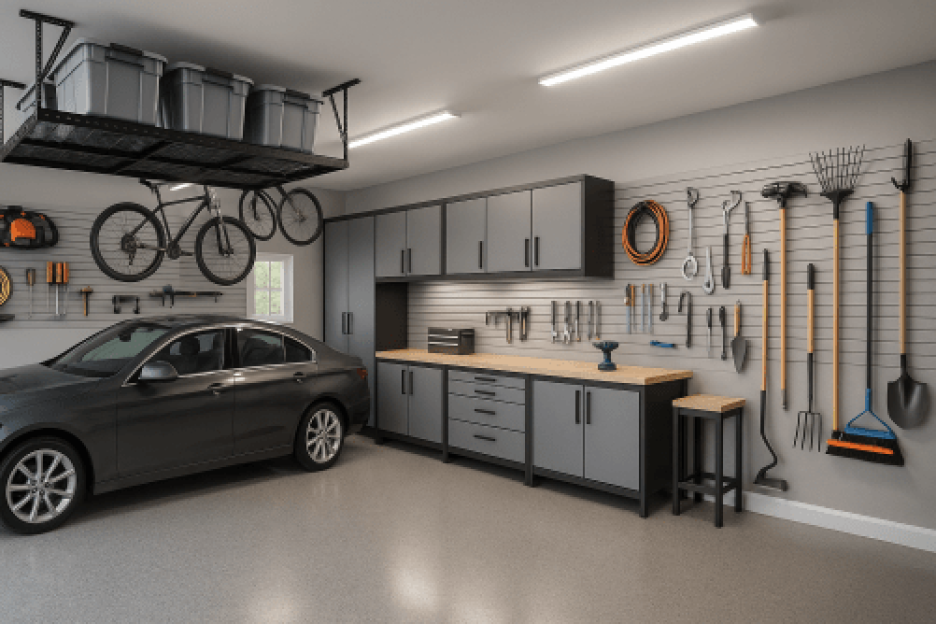You know that moment when you open your garage door and feel a wave of shame wash over you? That overwhelming sense of defeat as you navigate through a maze of holiday decorations, forgotten sports equipment, and mysterious boxes that haven’t been touched since your last move?
Your garage has become the dumping ground for everything that doesn’t have a home inside your house, and finding anything feels like embarking on an archaeological expedition. But here’s the thing â your garage doesn’t have to be a source of stress and embarrassment.
With the right storage system, it can become a functional, organized space that actually makes your life easier instead of harder.
Understanding Modern Garage Storage Solutions
The garage storage industry has evolved dramatically over the past decade. What once consisted of simple pegboards and basic shelving has transformed into sophisticated systems that maximize every square inch of available space. Today’s garage organization solutions combine durability with versatility, offering homeowners customizable options that adapt to changing storage needs.
Modern garage storage systems fall into several main categories, each designed to address specific organizational challenges. Wall-mounted systems utilize vertical space efficiently, while overhead storage solutions take advantage of often-wasted ceiling areas. Modular garage cabinets provide concealed storage for a cleaner appearance, and specialized racks accommodate everything from bicycles to lawn equipment.
The key to selecting the best garage storage system lies in understanding your specific needs. Consider factors like the size of your garage, the types of items you need to store, your budget, and whether you prefer visible or hidden storage. Many homeowners find that combining different storage types creates the most effective organizational solution.
Wall-Mounted Storage Systems: Maximizing Vertical Space
Wall organization represents one of the most efficient ways to reclaim floor space in your garage. These systems transform empty walls into functional storage areas, keeping frequently used items accessible while maintaining a clutter-free environment.
Slatwall Systems
Slatwall has emerged as the gold standard for garage wall storage. Unlike traditional pegboard, slatwall features horizontal grooves that accommodate a vast array of accessories including hooks, baskets, shelves, and specialized holders. The system’s flexibility allows you to reconfigure your storage layout as needs change, making it ideal for growing families or evolving hobbies.
Professional-grade slatwall panels typically measure 4Ã8 feet and can support significant weight when properly installed into wall studs. The grooves run continuously across the panels, providing virtually unlimited arrangement possibilities. Many systems feature powder-coated finishes that resist rust and scratches, ensuring longevity even in harsh garage environments.
Track Systems
Track-based wall storage offers another versatile solution. These systems use vertical or horizontal rails mounted to walls, with various attachments sliding along the tracks. This design allows for easy repositioning of storage accessories without tools, making seasonal reorganization simple.
Heavy-duty track systems can support substantial loads, with some rated for up to 100 pounds per linear foot. The modular nature of track systems means you can start small and expand as needed, making them budget-friendly for homeowners who want to build their storage gradually.
Pegboard Solutions
While considered more traditional, modern pegboard systems have evolved significantly. Today’s pegboards often feature metal construction rather than the pressed wood of yesteryear, offering superior strength and durability. Powder-coated steel pegboards resist moisture and won’t warp or deteriorate like their predecessors.
The hole pattern standardization means countless accessories are available, from simple hooks to specialized tool holders. Some innovative pegboard systems include integrated shelving and magnetic strips, creating hybrid storage solutions that maximize functionality.
Overhead Garage Storage: Utilizing Ceiling Space
Ceiling-mounted storage systems represent one of the most underutilized opportunities in garage organization. By moving seasonal items and rarely-used equipment overhead, you free valuable floor and wall space for daily-use items and vehicles.
Fixed Overhead Platforms
Stationary overhead storage platforms provide sturdy, permanent storage for bulky items. These systems typically consist of heavy-gauge steel frames that attach to ceiling joists, creating elevated storage areas. Quality platforms can support 300-600 pounds when properly installed, making them suitable for storage bins, camping gear, and seasonal decorations.
Installation requires careful planning to ensure adequate clearance for garage doors and vehicles. Most platforms adjust in height, allowing customization based on your garage’s dimensions. Some models include integrated lighting, improving visibility and safety when accessing stored items.
Motorized Lift Systems
For those seeking convenience and accessibility, motorized overhead storage lifts offer push-button operation. These sophisticated systems use electric motors to raise and lower platforms, eliminating the need for ladders. Advanced models include smartphone integration, allowing remote operation and monitoring.
Weight capacities for motorized systems typically range from 200-400 pounds, with lifting heights adjustable to accommodate various garage configurations. Safety features include automatic stops, overload protection, and manual override capabilities in case of power failures.
Pulley Systems
Manual pulley systems provide an affordable alternative to motorized lifts. These mechanical advantage systems use rope or cable configurations to make lifting heavy items manageable. Quality pulley systems feature smooth-operating mechanisms and locking features to secure loads at desired heights.
Common applications include bicycle hoists, kayak lifts, and storage platforms for bins. The simplicity of pulley systems makes them reliable and easy to maintain, with fewer components that could potentially fail compared to motorized alternatives.
Garage Cabinet Systems: Concealed Organization
Garage cabinets offer the advantage of hidden storage, creating a clean, professional appearance while protecting contents from dust and moisture. Modern garage cabinet systems range from budget-friendly options to premium solutions rivaling high-end kitchen cabinetry.
Steel Cabinet Systems
Heavy-duty steel cabinets dominate the premium garage storage market. These robust units feature welded construction, adjustable shelving, and locking mechanisms for security. Powder-coated finishes in various colors allow coordination with garage aesthetics while providing exceptional durability.
Professional-grade steel cabinets often include soft-close hinges, full-extension drawer slides, and integrated LED lighting. Modular designs enable customization, with options for tall storage units, base cabinets, wall-mounted units, and combination workbench systems.
Resin and Plastic Cabinets
For budget-conscious homeowners, resin and heavy-duty plastic cabinets offer affordable storage solutions. Modern plastic cabinets feature reinforced construction that rivals entry-level metal options while weighing significantly less. UV-resistant materials prevent fading and brittleness, ensuring longevity.
These lightweight cabinets excel in damp environments where metal might rust. Many models include ventilation features to prevent musty odors, making them ideal for storing sports equipment or gardening supplies. Modular connections allow multiple units to link together, creating cohesive storage walls.
Hybrid Cabinet Systems
Innovative manufacturers now offer hybrid cabinets combining materials for optimal performance. Steel frames with wood or composite doors provide strength with aesthetic appeal. Some systems integrate slatwall backing within cabinets, maximizing interior organization options.
These hybrid solutions often include specialized features like pegboard doors, magnetic tool strips, and removable bins. The combination of materials allows designers to optimize each component for its specific function, resulting in highly functional storage systems.
Specialized Storage Solutions
Beyond general storage systems, specialized solutions address specific organizational challenges common in garages. These targeted products maximize efficiency for particular items or activities.
Sports Equipment Organization
Active families often struggle with sports equipment storage. Specialized racks accommodate everything from golf bags to ski equipment, keeping gear organized and accessible. Ball storage systems use mesh bags or wire baskets to corral various sports balls, while vertical racks efficiently store bats, hockey sticks, and fishing rods.
Bicycle storage deserves special attention, as bikes often consume significant floor space. Options include wall-mounted hooks, ceiling hoists, freestanding racks, and vertical storage systems. Some innovative solutions store bikes horizontally along walls, minimizing protrusion into garage space.
Tool Organization Systems
Serious DIY enthusiasts and professionals require robust tool storage. Mobile tool chests provide portability with drawer organization for hand tools and small parts. Wall-mounted tool cabinets keep frequently used items at eye level, while magnetic tool strips offer instant access to metal tools.
Modular drawer systems allow customization with dividers and foam inserts, protecting valuable tools while maintaining organization. Some advanced systems include power tool charging stations, ensuring batteries remain ready for use.
Lawn and Garden Equipment Storage
Organizing lawn care equipment presents unique challenges due to awkward shapes and sizes. Specialized racks accommodate everything from rakes and shovels to string trimmers and leaf blowers. Heavy-duty hooks support lawn mowers vertically, freeing floor space.
Garden tool organizers often feature rubberized grips to prevent tools from sliding, while enclosed cabinets protect fertilizers and chemicals from children and pets. Some systems include dedicated spaces for hoses, sprinklers, and other irrigation equipment.
Installation Considerations and Best Practices
Proper installation ensures your garage storage system performs safely and effectively. Understanding weight limits, structural requirements, and installation techniques prevents accidents and maximizes system longevity.
Assessing Your Garage Structure
Before installing any storage system, evaluate your garage’s construction. Identify stud locations for wall-mounted systems and assess ceiling joist spacing for overhead storage. Older garages may require reinforcement before installing heavy storage systems.
Consider electrical outlet locations when planning layouts, especially for workbenches or charging stations. Ensure adequate clearance around garage door tracks and mechanisms to prevent interference with operation.
Weight Distribution and Safety
Proper weight distribution prevents system failure and structural damage. Wall-mounted systems require attachment to studs at recommended intervals, typically 16 or 24 inches. Overhead systems must connect to ceiling joists or blocking between joists for adequate support.
Follow manufacturer weight ratings conservatively, considering both individual component limits and total system capacity. Distribute heavy items across multiple attachment points rather than concentrating weight in single locations.
Professional Installation vs. DIY
While many garage storage systems market themselves as DIY-friendly, complex installations benefit from professional expertise. Overhead systems particularly warrant professional installation due to safety concerns and structural considerations.
Professional installers bring experience identifying potential problems and ensuring code compliance. They also typically warranty their work, providing peace of mind. However, basic wall hooks and simple shelving remain approachable DIY projects for handy homeowners.
Maximizing Storage Efficiency
Creating an efficient garage storage system extends beyond simply installing components. Strategic planning and organization principles maximize available space while maintaining accessibility.
Zone-Based Organization
Divide your garage into functional zones based on usage patterns. Create dedicated areas for automotive supplies, sports equipment, tools, and seasonal items. This approach simplifies finding items and maintaining organization over time.
Position frequently used items in easily accessible locations, reserving overhead and hard-to-reach storage for seasonal or rarely used belongings. Consider workflow when arranging zones, placing related items near each other to streamline projects.
Labeling and Inventory Systems
Clear labeling prevents the frustration of searching through multiple containers. Use weather-resistant labels on bins and shelves, including both contents and dates for seasonal items. Some organizers photograph container contents, attaching images for visual reference.
Digital inventory systems help track stored items, particularly useful for extensive collections or valuable equipment. Smartphone apps can catalog belongings with photos, locations, and notes, simplifying retrieval when needed.
Seasonal Rotation Strategies
Implement rotation schedules for seasonal items, moving current-season equipment to accessible locations. Store off-season items overhead or in back corners, maximizing prime storage space for immediate needs.
Create detailed lists of seasonal storage locations to simplify transitions. Some organizers use color-coded bins for different seasons, making identification quick and intuitive during rotation periods.
Cost Considerations and Budgeting
Garage storage systems span wide price ranges, from budget-friendly DIY solutions to premium professional installations. Understanding cost factors helps establish realistic budgets and identify best values.
Entry-Level Storage Options
Basic storage solutions include standalone shelving units, simple wall hooks, and plastic storage bins. These affordable options typically cost $100-500 total and provide immediate organization improvements. While lacking the sophistication of integrated systems, they offer practical storage for budget-conscious homeowners.
Wire shelving units provide versatile storage at minimal cost. Heavy-duty units support substantial weight while allowing air circulation. Combine these with clear storage bins for an organized appearance without breaking the bank.
Mid-Range Storage Systems
Mid-tier options include quality slatwall systems, steel shelving, and basic cabinet sets. Expect investments of $500-2,000 for comprehensive solutions covering significant wall space. These systems offer durability and flexibility, representing good long-term value.
Many homeowners find mid-range systems provide the best balance of features and affordability. Quality components ensure longevity while modular designs accommodate future expansion as budgets allow.
Premium Storage Solutions
High-end garage storage systems featuring custom cabinets, motorized lifts, and integrated workstations can exceed $5,000-10,000. These comprehensive solutions transform garages into showcase spaces with professional-grade organization.
Premium systems often include professional design consultations and installation services. While representing significant investments, these solutions add home value while providing unmatched functionality and aesthetics.
Maintenance and Longevity
Protecting your garage storage investment requires minimal but consistent maintenance. Regular care ensures systems remain functional and attractive for decades.
Cleaning and Care
Dust accumulation affects both appearance and functionality. Regular cleaning prevents buildup that can interfere with moving parts or harbor pests. Use appropriate cleaners for different materials â mild detergents for painted surfaces, specialized products for powder coatings.
Inspect systems periodically for loose fasteners, worn components, or damage. Address issues promptly to prevent progressive deterioration. Lubricate moving parts according to manufacturer recommendations, typically annually for most components.
Preventing Common Problems
Moisture represents the primary enemy of garage storage systems. Ensure adequate ventilation to prevent condensation, particularly in climates with temperature extremes. Use moisture-absorbing products in enclosed cabinets storing sensitive items.
Avoid overloading systems beyond rated capacities. Excess weight stresses components and attachment points, potentially causing catastrophic failure. When in doubt, distribute loads across multiple storage points rather than concentrating weight.
Upgrading and Expanding
Quality storage systems accommodate expansion as needs evolve. Plan initial installations with future growth in mind, leaving space for additional components. Choose systems from established manufacturers ensuring long-term parts availability.
Consider periodic reorganization to optimize changing storage needs. What works for young families may require adjustment as children grow and interests change. Flexibility in quality storage systems allows adaptation without complete replacement.
Smart Garage Storage Technology
Technology increasingly influences garage organization, with smart features enhancing traditional storage systems. These innovations improve accessibility, security, and inventory management.
App-Controlled Systems
Smartphone integration allows remote monitoring and control of motorized storage systems. Apps enable operation of overhead lifts, locked cabinet access, and even climate control for sensitive storage areas. Some systems send alerts when accessing restricted areas or detecting unusual activity.
Advanced applications include voice control through smart home assistants, allowing hands-free operation when carrying items. Integration with home automation systems enables scenarios like automatic lighting when entering the garage or notifications when doors remain open.
Security Features
Modern garage storage systems incorporate sophisticated security measures. Biometric locks on cabinets protect valuable tools and equipment. Camera integration provides visual verification of stored items and activity monitoring.
Smart locks offer keyless entry with user-specific codes, allowing controlled access for family members or service providers. Audit trails track access history, providing accountability for shared storage areas.
Climate Control Integration
Sensitive items benefit from climate-controlled storage environments. Smart systems monitor temperature and humidity, activating ventilation or dehumidification as needed. This protection proves valuable for electronics, photographs, and collectibles stored in garages.
Some premium cabinets include built-in climate control, creating micro-environments for specific storage needs. These systems prevent rust on tools, mold growth on fabrics, and degradation of rubber components.
Future Trends in Garage Storage
The garage storage industry continues evolving, driven by changing lifestyles and technological advancement. Understanding emerging trends helps future-proof storage investments.
Sustainable Materials
Environmental consciousness drives demand for eco-friendly storage solutions. Manufacturers increasingly use recycled materials and sustainable production methods. Bamboo components, recycled plastics, and low-VOC finishes appeal to environmentally aware consumers.
Modular designs supporting repair and reconfiguration extend product lifespans, reducing waste. Some companies offer take-back programs for old components, ensuring responsible disposal and recycling.
Multi-Functional Spaces
Garages increasingly serve multiple purposes beyond vehicle storage. Home gyms, workshops, and hobby spaces require flexible storage adapting to various activities. Convertible systems that transform between storage and workspace configurations address these evolving needs.
Murphy-style workbenches fold against walls when not in use. Retractable overhead storage creates clearance for tall vehicles or projects. These adaptable solutions maximize garage versatility without permanent space commitment.
Electric Vehicle Accommodation
Growing electric vehicle adoption influences garage storage design. Systems must accommodate charging equipment while maintaining organization. Cable management becomes crucial, preventing trip hazards and equipment damage.
Storage solutions increasingly include integrated charging stations and cable routing. Some systems position storage to create dedicated charging bays, optimizing garage layouts for electric vehicle needs.
Making the Right Choice for Your Garage
Selecting the ideal garage storage system requires balancing multiple factors. Consider immediate needs while planning for future requirements. Evaluate your budget realistically, including installation costs and potential garage modifications.
Start with a thorough garage assessment, measuring dimensions and identifying structural limitations. Inventory current belongings and anticipate future storage needs. This preparation ensures informed decisions aligned with your specific situation.
Consider phased implementation if budget constraints exist. Quality modular systems allow starting small and expanding over time. Prioritize high-use areas first, adding components as resources permit.
Remember that the best garage storage system is one you’ll actually use and maintain. Complex organizations that require significant effort often fail over time. Choose systems matching your organizational style and commitment level.
Professional consultation can prove valuable for complex installations or when maximizing challenging spaces. Many storage system retailers offer free design services, providing expert guidance in system selection and layout planning.
Conclusion
Transforming your garage from chaotic catchall to organized oasis is entirely achievable with the right storage system. Modern solutions offer unprecedented flexibility, durability, and functionality, accommodating virtually any organizational challenge. Whether you choose simple shelving or comprehensive cabinet systems, the key lies in selecting solutions aligned with your specific needs, budget, and maintenance preferences.
The journey to an organized garage begins with a single step. Start by assessing your space and belongings, then explore the various storage options available. Remember that the best system combines multiple storage types, utilizing walls, ceilings, and floor space efficiently. With proper planning and the right components, your garage can become a functional, organized space that enhances rather than hinders your daily life.
Invest in quality components that will serve you for years to come. While budget considerations matter, remember that garage storage systems represent long-term investments in your home’s functionality and value. Choose wisely, install properly, and maintain regularly to ensure your garage storage system continues delivering organization and convenience for decades ahead.







